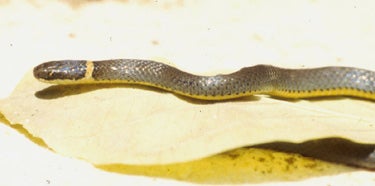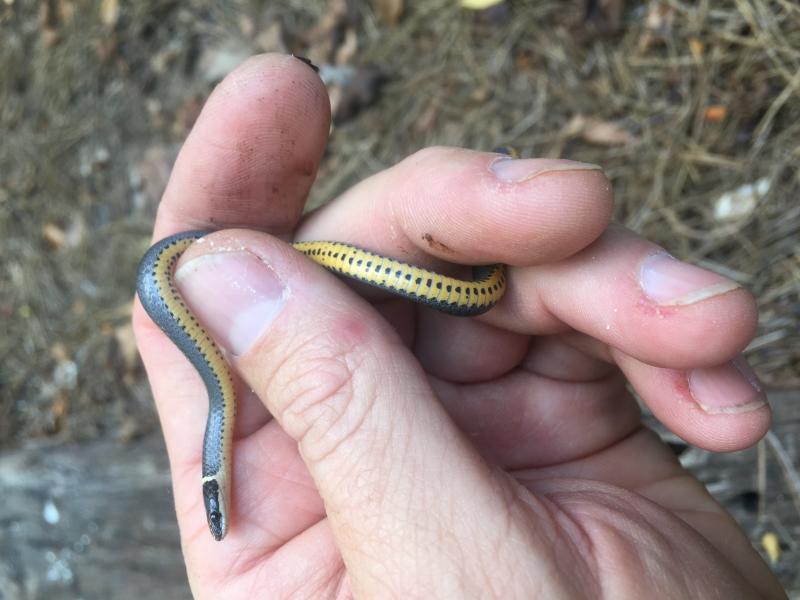SCIENTIFIC NAME:
Diadophis punctatus
OTHER NAMES:
None.
STATUS:
Fairly common statewide, but less abundant than in the past. Alabama populations are intergradient combinations involving 2 or all of 3 subspecies, D.p. punctatus (southern ringneck snake), D.p. edwardsi (northern ringneck snake), and D.p. stictogenys (Mississippi ringneck snake). Lowest Conservation Concern.
DESCRIPTION:
The ringneck snake is a small, slender snake that can reach a length of about 18 inches, though some have been captured up to 24 inches (average 10 to 15 inches). Its head is small, somewhat flattened with a rounded snout and is darker in color than the rest of the body. It has a slate blue to gray-black body. It has a narrow yellow or cream-colored ring around the neck from whence it gets its name. The belly is a yellow to orange with a single row of black half-moons down its midline. There are 13 described subspecies, of which 3 can be found in Alabama.
DISTRIBUTION:
Ringneck snakes are found throughout Alabama. It can also be found in all or portions of the lower 48 states with the exceptions of Montana, North and South Dakota and Wyoming.
HABITAT:
Ringneck snakes are found in wooded, terrestrial type habitats, commonly under objects such as stumps, logs and leaf litter, and can be found in gardens, flower beds and occasionally in salt marshes.
FEEDING HABITS:
Ringneck snakes feed on earthworms, slugs, insects and insect larvae, small amphibians and small reptiles. While not necessary on smaller prey items, ringneck snakes will partially constrict larger prey.
LIFE HISTORY AND ECOLOGY:
Ringneck snakes will lay four to five elongate, whitish eggs typically in rotten wood of a log or stump. At hatching, the young will measure 4 to 5 ½ inches in length. Ringneck snakes rarely bite when handled, typically discharging the contents of the cloaca as a predator avoidance technique. Other individuals may display the bright colored belly to startle off predators enough to escape. They can be found in association with other snakes like the Earth snake (Virginia spp.) and worm snakes (Carphophis amoenus). These are all part of a group described by Jackson* as the Little Land Snakes.
REFERENCES:
Mount, R. H., 1975. The Reptiles and Amphibians of Alabama. Ala. Agri. Expt. Sta., Auburn Univ., Auburn, AL. 347 pp.
*Jackson, Jeffery J. 1983. Snakes of the Southeastern United States. Cooperative Extension Service, The University of Georgia, College of Agri. 46 pp.
Behler, John L. and F. Wayne King, 1997. National Audubon Society Field Guide to North American Reptiles & Amphibians. Chanticleer Press, Inc. 744 pp.
AUTHOR:
Mitchell Marks, Wildlife Biologist, Alabama Division of Wildlife and Freshwater Fisheries.








